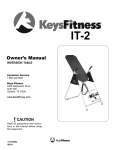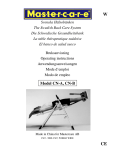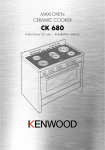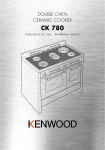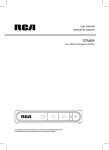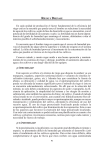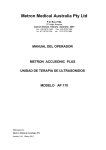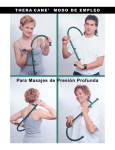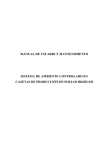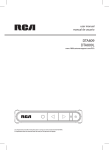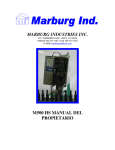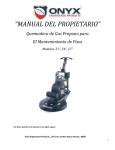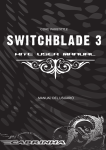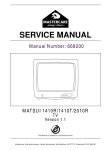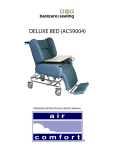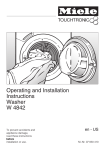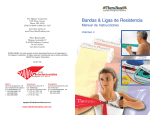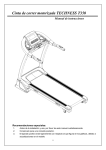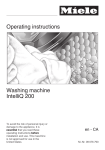Download Manual de Instrucciones
Transcript
U The Swedish Back Care System Back-A-Traction Instruction manual Manual de Instrucciones Model CN-A, CN-B Made in China for Swedish Backcare System, Inc. U.S. PATENT No. 4867143 CE ENGLISH We congratulate you on your decision to seek a healthier life through the use of Back-A-Traction from Mastercare. Back-A-Traction is a gravity traction table that will help you relieve and prevent back pain and the wearing out of joints. It is a good tool to help you regain your back health, and to maintain it for the rest of your life. Back-A-Traction's unique feature, the Sliding Backrest, moves on rollers on the steel frame. This patented feature makes it possible to obtain optimal beneficial traction at a low inversion angle. While your spine is extended, the back is perfectly supported allowing the muscles to relax completely. You will experience an unloading of the pressure of gravitational forces from your discs and joints. To get optimal results, you should alternate stretching exercises and total relaxation. The passive traction and the stretching exercises on the table involve stretching of the muscles, muscular attachments, tendons and crucial ligaments of your entire back and legs. In the beginning this may cause a slight stiffness, which is a sign that the mentioned parts of your body are not used to this kind of stretching. Even if you become sore in the beginning, you may continue your exercises with less intensity, as the soreness should disappear as the muscles and tendons increase their flexibility. Daily use of Back-A-Traction will lead to a healthier life. CAUTION ADVISED IN CERTAIN MEDICAL PRE-EXISTING CONDITIONS ALWAYS consult your doctor before starting a regular use of the bench if you are uncertain about the state of your health, or suffer from any of the following conditions,: Glaucoma, detached retina, conjunctivitis, uncontrolled hypertension (high blood pressure), impaired pulmonary functions, arrhythmia, carotid artery stenosis, severe vascular disease, aneurysm, tendency towards fainting or dizzy spells, cerebral sclerosis, recent stroke or transient ischemic attack, history of brain lesions, other heart or circulatory disorders for which you are being treated, severe back problems or spinal injuries, bone weakness (osteoporosis), recent unhealed fractures, medullary pins, artificial hip joints or other orthopedic supports surgically implanted, middle ear infection, recently had surgery, using special medication, ventral or hiatal hernia, tendency towards bleeding, extreme obesity, invertaphobia (fear of inversion itself), and pregnancy. IMPORTANT SAFEGUARDS Not for use by minors under the age of 18. Have others remain clear while the table is in use, to avoid bodily injury from moving parts. As with any therapy or exercise equipment, you should consult your doctor before regular use of Back-A-Traction. The table is designed for use by one person at a time, with both feet fastened in the foot-locking device. In the beginning, use Back-A-Traction in the presence of a person who is familiar with its functions. Before using Back-A-Traction on your own, you must be certain that you fully understand how the table works. Be sensitive to the signals from your body. Consult your doctor or physical therapist if you feel uncomfortable, have pain or notice any unusual changes that you think might prevent you from using Back-A-Traction. Do not use Back-A-Traction immediately after a meal, or if you have a temperature, a cold, or severe head- or ear ache. Back-A-Traction is designed for persons with a height between 4,6 and seven feet, and a maximum weight of 330 lbs. Make sure that: - the wires on the stand are stretched - it stands on a level, horizontal surface - all nuts and bolts are securely fastened - the foot lock is working perfectly 2 Learn how the two thumb catches work and make sure that they are both engaged. If you temporarily disengage one of the safety catches when adjusting the height, you must re-engage the safety catch when you are done with the height adjustment. If both safety catches are disengaged, the backrest will swing without safety stops and you may get injured. When using Back-A-Traction lying face down, you should always be assisted by another person, who is familiar with its operation. Before stepping up on the foot plate, always make sure that the catch for the height adjustment is in a locked position. If you do not balance well when operating Back-A-Traction, re-adjust the foot rest to obtain the best possible balance. (In order to make sure that the backrest will not rock back and forth when you do the stretching exercises, it is usually advantageous to have it adjusted so that the part where your upper body is resting weights a little more). Wiggle the backrest slightly when you loosen the safety catches. If the thumb catches works stiffly, the height is not properly adjusted. To correct this, the foot rest has to be extended. If your back is in a very bad condition when you start using Back-A-Traction, it will, for the first couple of weeks, probably be enough for you to just hang in it, with your arms over your head. Then, as your condition improves, you can begin to do the stretching exercise program. A BASIC STRETCHING EXERCISE PROGRAM Follow the instructions you have received. Be cautious and sensitive to the signals from your body. For best result you should relax and take some deep breaths between the different stretching exercises. It is also important that you relax as much as possible during each stretching exercise. The following instruction will tell you to repeat certain exercises. It is for you to decide if you want to repeat them, and how many times. An easy start is recommended. Increase muscular stretching and relaxation with each repetition. Most of the following stretching exercises should be done, if possible, with your arms over your head. 1. You must first adjust the balance of the back rest according to your height. Press to release the far thumb lock and fasten it open by swinging the safety catch down. This allows all adjustments to be made from one side. 2. Next, press the near thumb lock and rotate the back rest to the horizontal position where it locks in place. 3. To adjust the balance, pull the height and balance adjustment knob and slide the bar according to the guideline markings provided. Test the back rest and fine tune the balance to your height and weight as necessary. 4. Next, press the near thumb lock and rotate the back rest towards its vertical position. It will lock at a slight incline. Now, return the far thumb lock to the operating position by pressing the button and releasing the safety catch. You're now ready to use Back-A-Traction. As a first time user you should always have someone help you until you feel comfortable using Back-A-Traction. 5. Remove your shoes, and then unlock the foot restraint, swinging the handle to the wide open position. Step into BackA-Traction, sitting against the back rest while placing your feet between the restraining pads. Secure your feet with the foot restraint, moving along its ratchet until your feet are held, comfortably and securely between the pads. 6. Now, lean back onto the back rest and take hold of the hand grips with your thumbs on the buttons and press. Release the thumb locks and push back to the horizontal position where the back rest will lock in place. Before exercising, you should stretch by pushing against the hand grips. Throughout the session, remember to relax and breath deeply and allow Back-A-Traction to work, stretching the tension from your muscles, tendons and ligaments, the common causes of back pain. 7. After stretching, press and release the thumb locks and rotate further backwards to the first catch at 15 degrees, the position you should use for your first few weeks with Back-A-Traction. Repeat the stretching procedure by pushing, as before, against the hand grips. Now, raise your hands slowly over your head and prepare to exercise. First begin with a few repetitions of bending your feet under the restraint pads. 3 8. Next, alternate bending your knees in a slow and easy walking motion. Each exercise should be repeated a few times for best effect. Remember to relax and breathe deeply between each exercise. 9. The exercise involves arching and lifting your buttocks off of the back rest. 10. Next, push your neck flat to the back rest while lifting your shoulders upward. 11. After a few repetitions, place one hand on your stomach and then reach over your head with the other, as if trying to pick apples just out of reach. Now, repeat the process, this time holding your arm out to your side. You should alternate your palms up and down from time to time during this exercise. Finally, repeat the exercise holding your hand near your waist. From this finishing position, move right into the next exercise, moving your arm in circles as if swimming the backstroke. Repeat these hand and arm exercises with your other arm. End with your back flat to the backrest and both hands together on your stomach. 12. The next exercise involves a three part move. Raise both hands over your head and then twist your torso and hips to the right, raising the right knee at the same time. Return to the flat back, flat knee position and twist to the left side. Return to the flat position and repeat the move a few times. End the exercise by bringing your hands back to rest on your stomach. 13. The final exercise involves quarter sit-ups. Raise your head, shoulders, and upper back only, leaving the rest of your back flat to the backrest. Proceed only as you feel comfortable to do so. End by returning flat to the backrest and raising your arms over your head for a last reaching stretch. 14. Begin the dismount by taking hold of the hand grips, releasing the thumb locks, and returning to the horizontal position. Relax for at least 60 seconds and move your knees in a walking mode for a few repetitions as before. Then release the thumb locks and return to the 15 degree upright position. Pause again for a moment. 15. Finally, release the thumb locks and return the back rest to its last and most upright locking point. You should be able to slip a foot out from under the foot pads and then release the foot restraint to its open position. Step out and away from your Back-A-Traction. It is very important to relax after each session. Avoid lifting and strenuous movements, and take it easy for a few minutes. Now you have a basic stretching exercise program. Start with caution. In the beginning "hold" means a few seconds. After you have been training for some weeks it may mean 20 to 30 seconds. Notice the reactions of your body. Intensify the exercises gradually. Feel free to talk to your back specialist about an exercise program just for you. After some time, when you are familiar with Back-A-Traction and the reactions of your body, you can do the stretching exercises in the 30 degree inversion angle. (The second position after horizontal). Total relaxation is necessary to get the best results. 4 ADDITIONAL STRETCHING EXERCISES A. Put your hands on your shoulders. Roll your arms and shoulders slowly forwards and backwards. Relax. Breathe. Repeat. B. Clasp one wrist and pull the arm over your head in the long direction of the backrest. Then do the other arm. Relax. Take some deep breaths. Repeat. C. Clasp your hands together on your stomach. Turn your head as far as possible towards each side. Relax. Take some deep breaths. Repeat. The most important thing you do on the table is to relax, to let your muscles and tendons stretch. The muscles let “go" of their tension little by little as you "hang" and relax, and by this you regain your flexibility. There is also a beneficial "negative" pressure on your discs, a "suction" action, achieved from just "hanging". We recommend that you use Back-A-Traction one to three times per day, two to fifteen minutes per session. lt is important that you relax and take it easy for a few minutes after each session. You may find it very beneficial just to hang and relax during an entire session, and also to use Back-A-Traction face down. In many low back disc problem situations, it is very beneficial to use the table face down, especially just before going to bed. We also want you to be prepared that you may experience "popping" in your back as your spine is being aligned. Feel free to call us if you have any questions. ESPAÑOL Le felicitamos por su decision de procurar una vida mas saludable a través del uso de Back-A-Traction de Mastercare. Back-A-Traction es una mesa de tracción por gravedad que le ayudará a aliviar y prevenir el dolor de espalda y el desgaste de las articulaciones. La mesa le ayudará a recuperar la salud de la espalda y mantenerse así por el resto de la vida. El espaldar deslizante, característica exclusiva de Back-A-Traction, se desplaza sobre rodamientos en una base de acero. Esta característica patentada hace posible obtener una tracción beneficiosa óptima en un ángulo de inversión pequeño. Mientras su columna vertebral está extendida, la espalda está bien apoyada permitiéndoles a los músculos relajarse completamente. Experimentará una reducción de la presión de las fuerzas gravitacionales de los discos y articulaciones. Para obtener los mejores resultados, debe alternar ejercicios de extensión con una relajación total. La tracción pasiva y los ejercicios de extensión en la mesa incluyen el estiramiento de los músculos, las inserciones musculares, los tendones y los ligamentos fundamentales de toda la espalda y las piernas. Al principio esto pudiera causar una ligera rigidez, lo cual es un signo de que las partes mencionadas de su cuerpo no están habituadas a este tipo de estiramiento. Aun si usted se siente adolorido al principio, puede continuar los ejercicios con menos intensidad, ya que las molestias irán desapareciendo a medida que los musculos y tendones aumenten la fIexibilidad. El usa diario de Back-A-Traction le proporcionará una vida más sana. SE RECOMIENDA PRECAUCION CUANDO EXISTA DETERMINADA AFECCION PREEXISTENTE Si está inseguro del estado de su salud o si tiene alguna de las siguientes afecciones, SIEMPRE consulte a su médico antes del uso regular del Back-A-Traction: Glaucoma, desprendimiento de retina, conjuntivitis, hipertension no controlada (hipertensión arterial), deterioro de las funciones pulmonares, arritmia, estenosis de la arteria carótida, vasculopatía severa, aneurisma, tendencia al desmayo o al vértigo, esclerosis cerebral, accidente cerebro vascular o ataque de isquemia transitoria reciente, antecedentes de lesiones cerebrales, otros trastornos cardíacos o circulatorios debido a los cuales recibe tratamiento, problemas severos de la espalda o lesiones en la columna vertebral, fragilidad ósea (osteoporosis), fracturas recientes que aún no han sanado, clavos medulares, prótesis articulares de la cadera u otros soportes ortopédicos implantados quirúrgicamente, infección del oído medio, cirugía reciente, uso de medicamentos especiales, hernia ventral o hiatal, tendencia al sangramiento, obesidad extrema, miedo a tener el cuerpo en posición inversa (de cabeza) y embarazo. 5 MEDIDAS DE PROTECCION IMPORTANTES No deben utilizarlo menores de 18 años. No deje que otras personas estén a su lado cuando esté utilizando la mesa para evitar lesiones con las partes moviles. Como en el caso de cualquier equipo terapéutico o de gimnasia, debe consultar a su médico antes del uso regular de Back-A-Traction. La mesa está diseñado para usarla una sola persona a la vez, con los pies asegurados en el sujetador. Al principio debe utilizar Back-A-Traction con alguien que esté familiarizado con su funcionamiento. Antes de utilizar Back-A-Traction, debe asegurarse de que entiende bien cómo trabaja el equipo. Esté alerta ante las señales de su cuerpo. Si se siente incómodo, tiene dolor o nota cambios inusuales que usted cree que podrían impedirle usar el equipo, consulte a su médico o terapeuta. No utilice Back-A-Traction inmediatamente después de comer, o si tiene fiebre, gripe o un intenso dolor de cabeza / oído. Back-A-Traction está diseñado para personas de una estatura entre 4,6 a siete pies y hasta 330 libras de peso. Asegúrese de que: - los cables en la base están tensos - está nivelado en una superficie horizontal - todas las tuercas y pasadores están bien apretados - el soporte de los pies funciona a la perfección Aprenda cómo funcionan los dos seguros a nivel de los pulgares y asegúrese de que ambos están enganchados. Si usted zafa temporalmente uno de los seguros cuando ajuste la altura, debe colocarlos de nuevo cuando termine el ajuste. Si ambos seguros están zafados, el espaldar se balanceará sin nada que lo detenga y se podría lesionar. Cuando usa la Back-A-Traction acostado cara abajo, siempre debe ayudarle otra persona que esté familiarizada con las funciones de la mesa. Antes de situar los pies en el soporte, asegúrese siempre de que el seguro para ajustar la altura esté en posición de cierre. Si no tiene el equilibrio adecuado al utilizar Back-A-Traction, reajuste el soporte de los pies para obtener el mejor equilibrio posible (para asegurarse de que el espaldar no oscile de un lado a otro cuando haga los ejercicios de extensión, corrientemente resuelve la situación ajustándolo de manera que la parte donde descansa la parte superior de su cuerpo pese un poco más). Mueva el espaldar ligeramente cuando libere los seguros. Si los cierres de las agarraderas trabajan rígidamente, la altura no está debidamente ajustada. Para corregir esto, debe extender el soporte para los pies. Si su espalda está en muy malas condiciones cuando comience a utilizar Back-A-Traction, probablemente será suficiente para usted sólo colgarse, con los brazos sobre la cabeza, durante las dos primeras semanas. Cuando su estado sea mejor, puede comenzar a hacer el programa de ejercicios de extensión. UN PROGRAMA BASICO DE EJERCICIOS DE EXTENSION Siga las instrucciones que ha recibido, sea cauteloso y esté alerta ante las señales de su cuerpo. Para obtener mejores resultados debe relajarse y respirar profundamente varias veces entre los ejercicios de extensión diferentes. Es también importante que se relaje tanto como sea posible durante cada ejercicio de extensión. Las siguientes instrucciones le indicarán que repita determinados ejercicios. La decisión de repetirlos y cuántas veces lo hará, es suya. Se recomienda un comienzo suave. Incremente la extensión muscular y el relajamiento con cada repetición. Muchos de los siguientes ejercicios de extensión deben hacerse, si se puede, con los brazos sobre la cabeza. 1. Primero debe ajustar el balance del espaldar de acuerdo con su estatura. Apriete el cierre más alejado para liberarlo y asegúrelo en la posición abierta moviendo el seguro hacia abajo. Esto permite hacer todos los ajustes desde un lado. 2. A continuación, apriete el cierre más cercano y haga girar el espaldar hasta la posición horizontal donde se fijará. 6 3. Para ajustar el balance, hale la perilla de ajuste de la altura y el balance, y deslice la barra de acuerdo con las marcas de la guía adjunta. Chequee la posición del espaldar y ajuste adecuadamente el balance de acuerdo con su estatura y peso. 4. Luego, oprima el cierre más cercano y haga girar el espaldar hacia la posición vertical que es la posición inicial. Vuelva a colocar el cierre más alejado en la posición de operación oprimiendo el botón y liberando el seguro. Ahora usted está listo para utilizar Back-A-Traction. Como es la primera vez que lo hace debe siempre tener a alguien que le ayude hasta que se acostumbre a utilizar Back-A-Traction. 5. Quítese los zapatos y suelte los sujetadores para los pies, moviendo la agarradera a la posición de abertura máxima. Suba al equipo, sentándose contra el espaldar mientras pone los pies entre las almohadillas. Asegure los pies con el sujetador, ajustando el trinquete hasta que los pies estén sujetos, confortables y seguros entre las almohadillas. 6. Ahora, acuéstese sobre el espaldar y tome fuertemente las agarraderas con los pulgares sobre los botones y oprímalos. Libere los cierres y empuje hasta la posición horizontal donde el espaldar se fijará en su sitio. Antes de hacer los ejercicios, debe estirarse empujando contra las agarraderas de mano. Durante la sesión, recuerde relajarse y respirar profundamente y dejar que Back-A-Traction trabaje, aflojando la tensión de los músculos, tendones y ligamentos, las causas más frecuentes de dolor de espalda. 7. Después de estirarse, oprima y libere los cierres y gire hacia atrás hasta el primer seguro a 15 grados, la posición que usted deberá utilizar durante las primeras semanas con Back-A-Traction. Repita el estiramiento empujando como antes contra las agarraderas. Ahora, alce las manos lentamente sobre la cabeza y prepárese para hacer ejercicios. Primero comience con una serie de repeticiones flexionando los pies debajo de las almohadillas de sujeción. 8. Posteriormente, alterne la flexión de las rodillas en un movimiento de paso suave y lento. Cada ejercicio debe repetirse varias veces para obtener un mejor efecto. Recuerde relajarse y respirar profundamente entre cada ejercicio. 9. El ejercicio comprende arquear y separar los glúteos del espaldar. 10. Luego, pegue el cuello al espaldar mientras levanta los hombros. 11. Después de algunas repeticiones, ponga una mano sobre el estómago y alce la otra sobre la cabeza, como si estuviera tratando de alcanzar manzanas que estuvieran alejadas de usted. Ahora, repita el proceso, esta vez manteniendo el brazo alejado del costado. Debe alternar las palmas hacia arriba y hacia abajo de tiempo en tiempo durante este ejercicio. Finalmente, repítalo acercando la mano a la cintura. Desde esta posición final, pase inmediatamente al otro ejercicio, moviendo el brazo en círculos como si estuviera nadando de espaldas. Repita este ejercicio de mano y brazo con el otro brazo. Termine con la espalda descansando en el espaldar y las dos manos juntas sobre el estómago. 12. El próximo ejercicio comprende un movimiento en tres partes. Levante ambas manos sobre la cabeza y entonces gire el torso y la cadera hacia la derecha, alzando al mismo tiempo la rodilla derecha. Regrese a la posición acostado sobre la espalda y con las piernas extendidas y baje la rodilla y gire hacia la izquierda. Regrese a la posición acostado y repita el movimiento unas cuantas veces. Termine el ejercicio volviendo a poner las manos sobre el estómago. 13. El ejercicio final comprende los abdominales (en un ángulo aproximado de 25 grados). Alce la cabeza, los hombros y la parte superior del torso solamente, dejando el resto de la espalda descansando sobre el espaldar. Hágalo solamente hasta donde se sienta cómodo. Concluya apoyándose completamente en el espaldar y alzando los brazos sobre la cabeza para estirarse por última vez. 7 14. Comience a bajarse del equipo asiendo fuertemente las agarraderas, liberando los cierres y volviendo a la posición horizontal. Descanse por lo menos 60 segundos y mueva las rodillas varias veces como si caminara. Entonces libere los cierres y regrese a la posición erguida a un ángulo de 15 grados. Descanse un minuto. 15. Finalmente, libere los cierres y regrese el espaldar a su último punto de cierre más vertical. Debe poder deslizar un pie fuera de las almohadillas y entonces liberar el sujetador para abrirlo. Salga de Back-A-Traction. Es muy importante tomar un descanso depués de cada sesión. Evite los movimientos de levantamiento que requieran grandes esfuerzos. Descanse durante unos minutos. Ahora tiene un programa básico de ejercicios de extensión. Comience con precaución. Al principio "detenerse" implica unos cuantos segundos. Luego de que se haya entrenado por algunas semanas puede significar de 20 a 30 segundos. Fíjese en las reacciones de su cuerpo. Intensifique gradualmente los ejercicios. Hable con su especialista para que le indique un programa de ejercicios individual. Después de algún tiempo, cuando esté familiarizado con Back-A-Traction y las reacciones de su cuerpo, puede hacer los ejercicios de extensión en un ángulo de inversión de 30 grados (la segunda posición luego de la horizontal). Es necesario relajarse totalmente para obtener los mejores resultados. EJERCICIOS DE EXTENSION ADICIONALES A. Ponga sus manos en los hombros, mueva los brazos y los hombros lentamente hacia adelante y hacia atrás en sentido giratorio. Descanse, respire, repítalo. B. Agárrese una muñeca y levante el brazo sobre la cabeza extendiéndolo lo más posible sobre el espaldar, entonces repítalo con el otro brazo. Descanse, respire profundamente, repítalo. C. Una las manos sobre su estómago. Gire la cabeza lo más posible hacia cada lado. Descanse, respire profundamente, repítalo. Lo más importante que debe hacer en la mesa es relajarse, para dejar que los músculos y tendones se estiren. Los músculos liberan su tensión poco a poco en la medida en que usted se "cuelga" y relaja y con esto usted recupera su flexibilidad. Hay también una beneficiosa presión "negativa" sobre sus discos, una acción de "succión", lograda solamente con "colgarse". Recomendamos que utilice el sistema Back-A-Traction de una a tres veces diarias, con sesiones de 2 a 15 minutos. Es importante que usted se relaje y descanse unos minutos despues de cada sesión. Puede encontrar muy beneficioso el colgarse y descansar durante toda una sesión, y también utilizar el equipo en posición boca abajo. En muchos problemas con los discos de la región lumbar, es muy beneficioso utilizar la tabla cara abajo, especialmente antes de acostarse. Queremos también que se prepare para la posibilidad de experimentar "crujidos" en su espalda en la medida en que su columna vertebral se va alineando. Llámenos si tenga alguna pregunta. 8 Exclusive Limited Warranty Swedish Backcare System, Inc., warrants to the purchaser that should this product be defective by reason of improper workmanship and/or material, warranty repair will be provided without charge for 90 (ninety) days from the date of the original retail purchase, and we will repair or replace, at our option, any defective parts without charge for 2 (two) years from the date of the original retail purchase. Purchaser must notify Swedish Backcare System, Inc., of any defect within the applicable warranty time period in order to qualify for warranty service. ANY EXPRESS WARRANTY NOT PROVIDED HEREIN, AND ANY REMEDY WHICH, BUT FOR THIS PROVISION, MIGHT ARISE BY IMPLICATION OR OPERATION OF LAW, IS HEREBY EXCLUDED AND DISCLAIMED. UNDER NO CIRCUMSTANCE SHALL SWEDISH BACKCARE SYSTEM, INC., BE LIABLE TO PURCHASER OR ANY OTHER PERSON FOR ANY INCIDENTAL, SPECIAL OR CONSEQUENTIAL DAMAGES, WHETHER ARISING OUT OF BREACH OF WARRANTY, BREACH OF CONTRACT, OR OTHERWISE. ------------------------------------------------------------------------------------------------------------------------WARRANTY REGISTRATION CARD The warranty registration card should have the information necessary to identify the original purchaser, the product type, and identification number. Accordingly, the following information should be included: 1). Name ............................................................................................................ 2). Address ............................................................................................................ 3). Phone number ……………………………………………………………………… 4). Date of purchase ……………………………………………………………………… 5). Product Model Number ……………………………………………………………………… 6). Serial Number ……………………………………………………………………… 7). Other I.D. Information ……………………………………………………………………… 9









